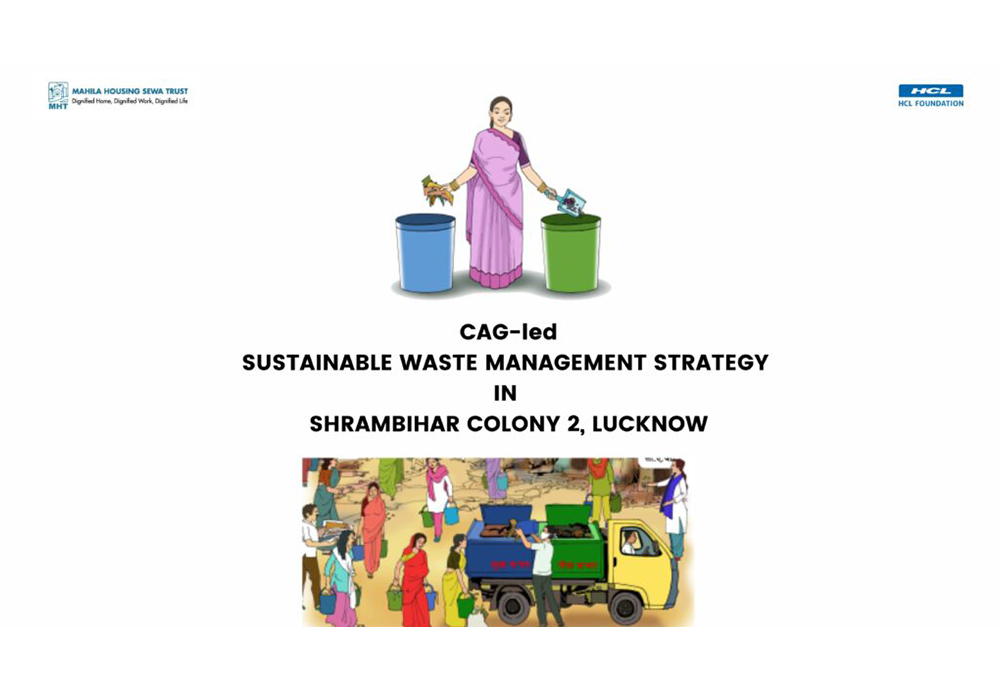
CAG-led sustainable waste management strategy in Shrambihar colony 2, Lucknow
CAG-led sustainable waste management strategy in Shrambihar colony 2, Lucknow
July 14, 2021adminBlogNo Comments
Community, as led by the CAG, identifies the problems and finds solution for waste-management household-level waste segregation not dumping in open and working towards greening the dump yard.
MHT Lucknow
The CAG members in Shrambihar colony 2, Lucknow identified that dumping waste in open, emptying household waste into open drains-the probable adverse health impacts of these practices as an unaddressed problem in their community, for which MHT Lucknow team guided them towards sustainable waste-management methods.
Mahila Housing Trust (MHT) invests in developing ‘collectives of grassroots women’- Community Action Group (CAG) to ensure responsible urban development, that sustains beyond MHT’s engagement. These women leaders identify the problems faced a thee community, ward and city-level and later work towards resolving those.Caption: (L) The dump yard (R) Open-drains with where people also disposed waste
At Shrambihar, when this issue was identified by the CAG and brought up in meets with MHT staff, it was also understood that that community was unaware of the services of solid waste collection, provided by Lucknow Municipal Corporation (LMC).
MHT team with support from HCL Foundation started to generate awareness amongst the CAG women-leaders and made a nighrani (surveillance)committee dedicated to work towards understanding the problem and reasons for community to dump waste in open.Caption: Women leaders of the nighrani committee (surveillance committee)
A one-day campaign on sustainable solid waste management was designed for 22nd June,2021.
Communities were sensitized on not dumping waste in open and how disease-spreading pathogens breed in dump yards. The nighrani committee was introduced to the community. The CAG women leaders through meetings, generated awareness on segregating waste at household level, for which two different dustbins were given. Caption: (L) MHT team sensitizing the community through IEC material (R) A community woman posing with the dustbins given by MHTCaption: (L) Dustbins for dry and wet waste (C) An illustration to sensitize community to segregate their waste at home (R) Community woman putting dry waste in the designated bin
It was further explained that the dry-waste could be en-cashed by selling it to a kabariwallah and the wet-waste can be turned to compost, nurturing the plants in the community.
Caption: (L) An illustration to explain the community that the dry waste can be sold-off and (R) wet-waste can be used as compost
Further, a letter was written to the officials of Lucknow Municipal Corporation (LMC) to request cleaning of the dump-yard and facilitate an otherwise irregular waste-collector vehicle to daily visit the slum. A meet with the officials of Lucknow Municipal Corporation (LMC) was organised. As an outcome of the meet, the community was encouraged to empty their household level bins in the LMC mobile waste collection van which visits the slum daily.Caption: (L) An application by community members to LMC (R) An illustration to sensitize the community to dump segregated waste (ii) Regular visit of waste collector vehicle
The LMC was requested to place a community-level bin as well, for those who skip emptying bins or generate more waste at home, to empty their waste there.Caption: A community woman dumping waste in the community-level waste-bin placed by LMC, post the campaign by MHT
The identification of a 30-year old practice as a problem by community women leaders and such behaviour change from the entire community is impressive to witness. “Most people now refrain littering anywhere in the slum. Children behave responsibly which is overwhelming and assuring. Understanding how cleanliness and hygiene are connected made us reflect our actions and change our behaviour and community’s behaviour too” shares Kirmalaben, a nighrani community member. She adds, “It will take some time and some more efforts, but we’re hopeful of a waste-free slum.” The nighrani committee continues to monitor the waste-management practices by the community.
SP Mishra, Supervisor, LMC, Zone 2, shared, “How local administration and NGOs partnership can work for community-good is exemplified yet again with this campaign and its outcomes.”
The efforts did not stop here, it was decided to clean the dump-yard and beautifying the spot.Caption: (i) The LMC staff cleaning the dump yard (ii) The dump yard being leveled up and cleared (iii) Post-initialy clean-up of teh dump yard scenario
INR 10 from each households was collected to buy saplings, also to imbibe a sense of ownership to nurture those in future. Because the dump yard had lots of waste since over 30 years, it is still going to take sometime for the community and LMC to clean it and level it up to grow trees here.
This sustainable waste management strategy implemented by Mahila Housing Trust jointly with the community, is supported by HCL Foundation
